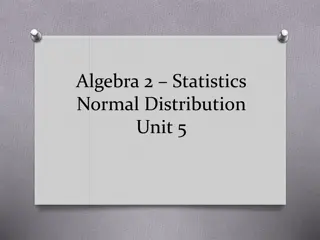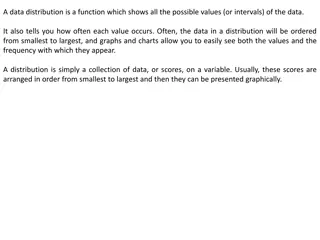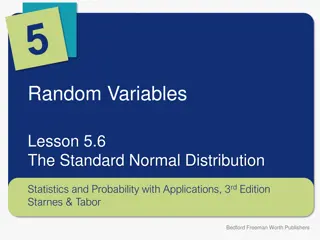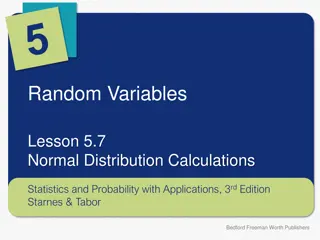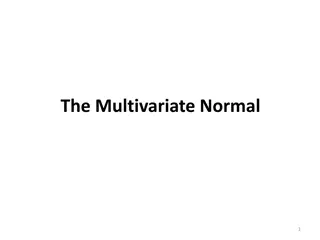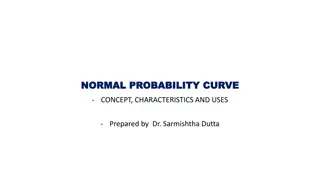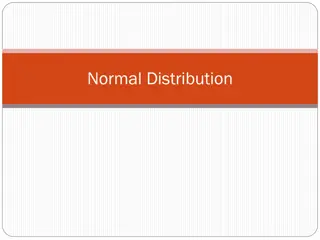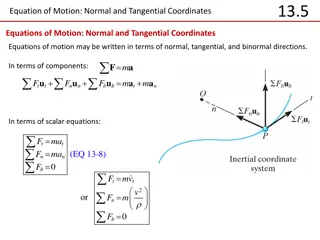Understanding Normal Distribution and Its Business Applications
Normal distribution, also known as Gaussian distribution, is a symmetric probability distribution where data near the mean are more common. It is crucial in statistics as it fits various natural phenomena. This distribution is symmetric around the mean, with equal mean, median, and mode, and denser in the center. In business, normal distribution is used for sales forecasting and risk evaluation, helping companies plan for future events and assess risks. The Central Limit Theorem states that sample means approach a normal distribution, with applications in various scenarios.
Download Presentation

Please find below an Image/Link to download the presentation.
The content on the website is provided AS IS for your information and personal use only. It may not be sold, licensed, or shared on other websites without obtaining consent from the author. Download presentation by click this link. If you encounter any issues during the download, it is possible that the publisher has removed the file from their server.
E N D
Presentation Transcript
Normal Distribution Normal Distribution , also known as Gaussian Distribution, is a probability distribution that is symmetric about the mean, showing that data near mean are more frequent in occurrence than data far from the mean. It is also known as the Gaussian distribution and the bell curve. The general form of its probability density function is-
Normal Distribution in Statistics The normal distribution is the most important probability distribution in statistics because it fits many natural phenomena. Many things closely follows normal distributions: Heights of people Size of things produced by machines Errors in measurements Blood Pressure Marks on a test
Features of Normal Distribution: Normal Distributions are symmetric around their mean. The mean, medianand mode of a normal distribution are equal. The area under the normal curve is equal to 1. Normal Distributions are denser in the center and less dense in the tails. Normal the mean ( ) and the standard deviation (?). Distributions are defined by two parameters, 68% of the area of a normal distribution is within one standard deviation of the mean. Approximately 95% of the area of a normal distribution is within two standard deviations of the mean.
Business Applications Sales Forecasting: Normal Distributions are used to predict future levels of sales. It is essentially impossible to predict the precise value of a future sales level; however, business still need to be able to plan for future events. Using a scenario analysis bases on probability distribution can help a company frame its possible future values in terms of likely sales level and worst-case and base-case scenario. By doing so the company can base its business.
Risk Evaluation: In addition to predicting future sales levels, probability distribution can also be a useful tool for evaluating risk. Consider, for example, a company considering entering new business line. If the company needs to generate $500000 in revenue in order to break and their probability distribution tells them that there is a 10% chance that revenues will be less than $500000, the company knows roughly what level of risk it is facing if it decides to pursue that new business line.
Applications of Central Limit Theorem The Central Limit Theorem states that the sampling distribution of the sample means approaches a normal distribution as the sample size gets larger no matter what the shape of the population distribution. The probability distribution for total distance covered in a random walk (biased or unbiased) will tend toward a normal distribution. Flipping many coins will result in a normal distribution for the total number of heads (or equivalently total number of tails). From another viewpoint, the central limit theorem explains the common appearance of the "bell curve" in density estimates applied to real world data. In cases like electronic noise, examination grades, and so on, we can often regard a single measured value as the weighted average of many small effects. Using generalisations of the central limit theorem, we can then see that this would often (though not always) produce a final distribution that is approximately normal.
Application It is used to measure the mean or average family income of a family in a particular region. To create a range of values which is likely to include the population mean, we can use the sample mean.




